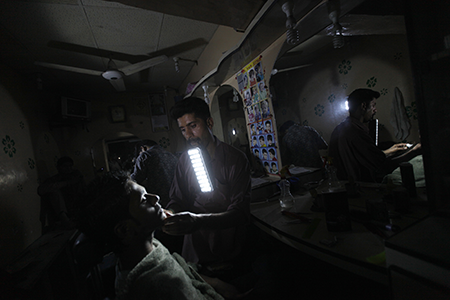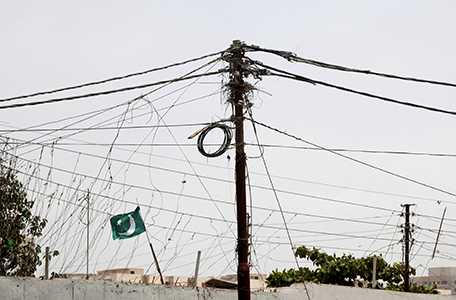As Prime Minister Imran Khan publicly admitted recently, the challenges facing the country’s power sector gives him sleepless nights at times. The fundamental issues are well known, and the burden is now on the government to follow through on the difficult structural changes required for a sustainable and paradigm shift in this space.
One of the frequently asked questions is, how and why the circular debt in the power sector has almost doubled in the last two years to almost Rs. 2,300 billion today. Let me attempt to answer that in simple terms, before outlining some of the steps the government is undertaking to arrest the increase in overall debt and consumer price. When this government took over in 2018, it did indeed inherit a broken economy. There was a significant devaluation of the rupee as well as consumer price inflation, followed by an interest rate hike. All these factors, contributed to the need to increase electricity prices that were frozen — as is typically the case in a political economy like ours — a year before the last general elections. Consequently, the tariff had to be jacked up by 20 percent or thereabouts which, under the extremely stressed macroeconomic environment, further suppressed the electricity demand and usage.

As if the country’s macroeconomic challenge wasn’t enough to contend with, the sector was also hit by the COVID-19 global pandemic in early 2020, which further curtailed socio-economic activity and power consumption, along with a policy decision to freeze any further increase in consumer tariffs. That necessary decision added an extra Rs. 225 billion to the circular debt buildup in 2020. All of this, in the context of a “tsunami” of new independent power producers (IPPs) and other power projects that have come online recently, added another Rs. 250 billion of incremental take-or-pay capacity charges in the sector. On average, these recent projects are at least 25 percent more expensive than they should have been, are 40-50 percent more than our capacity requirements in the near term and are nearly all front-loaded in a manner that their initial tariffs are twice their later years’ average.
The cost of supplying agricultural tube wells in Balochistan, and subsidising the provision of electricity to AJK, adds almost Rs. 100 billion per year to the circular debt
Last but not least, we all know that our last mile distribution sector is broken and costs the exchequer almost Rs. 200 billion of losses per year, mainly incurred by four distribution companies (DISCOs), in addition to the Rs. 150 to 200 billion of annual tariff differential subsidies picked up by the federal government. I think the time has now come to start sharing these costs with the respective provincial governments on a 50:50 basis. Likewise, the cost of supplying agricultural tube wells in Balochistan, and subsidising the provision of electricity to AJK, adds almost Rs. 100 billion per year to the circular debt. Further, the interest payable on the power sector’s “stock” of debt is Rs. 175 billion per year, out of which only about Rs. 50 billion is recovered from the consumers as a surcharge. Then we have the K-electric issue that costs the sector around Rs. 70 billion a year in unpaid bills, that is projected to further increase as we enhance the grid supply from 650 megawatts (MW) to around 2000 MW to the people of Karachi in the next two to three years.
So, what’s our holistic plan to “reform” the power sector in the short-to-medium term? Let us start by acknowledging the positive fact that we now have a reasonably diversified energy mix (hydro, wind, solar, local and imported coal, local and imported gas, etc.) and a significant stake of domestic as well as foreign private sector financiers and operators in this space. However, as discussed ad nauseam, the unaffordable cost of electricity generation, the continued leakages in the distribution system and the resultant suppressed demand and circular debt build-up have made this critical pillar of our economy financially unsustainable.
The recent signing of MOUs with about 50 IPPs is an important step towards reducing the end consumer tariff, and both sides are committed to taking this initiative across the finish line in the next few weeks. Along with the government-owned power plants, and those that came under the 2015 policy, the expected savings are in the trillions and do move the needle, especially on account of avoided currency devaluation-related tariff increases. While no government wishes to renegotiate signed contracts, the harsh reality is that our economy simply cannot afford to pay the 30 percent dollar-indexed annual Return on Equity, especially on the more recent power projects that, in hindsight, could and should have been priced less generously. In phase two, we would also be requesting the project finance lenders to extend the maturity of their debt beyond the typical 10-to-12 year tenor to smoothen the “front-loaded” profile of the tariffs and provide consequential relief to the rate-payers. Pakistan should always remain a welcoming investment destination, but the key lesson learnt is that all counterparties to such long-term contractual relationships must also consider, as a key variable, the financial sustainability, or otherwise, of the ecosystem.

We also now need to decisively move away from the single-buyer, sovereign-guaranteed, take-or-pay contractual structure that has unfortunately promoted the rent-seeking culture, that many assume to be the only option on the table. On the contrary, there should be different pockets of private capital that are willing to take a long-term market view on the overall demand/supply dynamics in the country’s power sector, without the need for a State backstop on volume or price. To achieve this long overdue objective, the government and the regulator have recently approved an 18-month road map to set up a wholesale commodity exchange by early 2022 that will allow multiple buyers and sellers to trade electricity, including under a take-and-pay regime, that should help reduce the consumer tariff, improve service and share the federal government’s financial burden with private sector participants, traders, and underwriters. A recently revised wheeling regime should also facilitate private business-to-business flow of electricity to increase overall economic output as the “big picture” policy outcome while also providing a reasonable, level playing field to the incumbent intermediaries to recover their legitimate, stranded cross-subsidy and other such costs.
The Pakistan Government’s recent announcement to provide 25 to 50 percent tariff relief to various categories of industrial customers for their incremental power consumption, and elimination of the distinction between peak and non-peak rates, is designed to increase power demand, economic output and employment opportunities, particularly in the small-and-medium enterprise sector. We all know that our industrial tariffs are among the highest in the region (on average 25 percent higher than those in our neighbouring countries), which has resulted in gradual de-industrialisation over the years, as evidenced by the sub-optimal correlation between electricity consumption and GDP growth rate in Pakistan over the last 10 years. This pricing signal (alongside an imminently similar one for indigenous natural gas) should also incentivise a significant proportion of those captive power consumers of approximately 5000 MW to switch back to the national grid as their primary source of input power. In formulating this three-year industrial tariff relief policy, against the backdrop of IMF discussions, the government rightly and boldly opted for a measured stimulus package that should more than pay for itself over the coming months.
Outright privatisation is perhaps not a feasible policy option in the near term, but a public-private partnership arrangement between the federal government, the respective provincial governments and a private sector operator should be the interim way forward.
Much has been said and written about reforming the power distribution companies. Outright privatisation is perhaps not a feasible policy option in the near term, but a public-private partnership arrangement between the federal government, the respective provincial governments and a private sector operator should be the interim way forward. The last mile power distribution and retail segment is a “local business” that cannot and must not be centrally handled from Islamabad if we are to achieve a truly sustainable and much needed turnaround in this space. An incentive-based, 5-year management contract proposition, along with the freedom to implement a mutually agreed business and value creation plan, and real skin in the game for the provinces, is being fleshed out with various stakeholders. This will coincide with the loss of monopoly and retail supply exclusivity for power distribution companies throughout Pakistan over the next three years or so. As with the wholesale trading platform referred to earlier, the ‘consumer choice’ plan is a step in the right direction as we saw in the telecommunication sector, post its liberalisation. As a policy matter, we should now be rewarding efficiency, and vice versa, by doing away with the uniform pricing of electricity across Pakistan. For instance, if Islamabad Electricity Supply Company (IESCO) has the lowest transmission & distribution (T&D) loss of 8.65 percent, there is no reason why its consumers should be charged a national T&D average of 15.53 percent to compensate for the inefficiencies of other DISCOs in the country. Let the best performing company charge the lowest distribution tariff to its consumers and let the provinces choose to subsidise from their own coffers, if they wish to maintain a certain rate.
Moreover, the distribution companies now need to work harder to zero in on the actual defaulters and thieves, through readily available technological and administrative solutions, instead of resorting to “collective punishment” in the name of a revenue-based, load-shedding regime on high loss feeders.

A holistic and long-term generation capacity rollout plan (on a least cost principle), including retirement of some of the older inefficient government and privately owned plants, an associated T&D infrastructure augmentation plan, and a host of other demand & supply input variables, is in the process of being fine-tuned, arguably for the first time, as an integrated planning tool for policy-makers. Given the big difference in peak power demand between the summer and winter periods, we do need to now move to a take-and-pay regime, or some hybrid form of it, to reduce the financial burden on the State. Furthermore, there is now a realisation that the scheduled financial close and commercial operation dates of the various upcoming power projects in the pipeline may need to be pushed back to align more closely with their optimal usage and the actual need of the economy. Simply put, and notwithstanding the contractual understanding, pragmatic business and common sense needs to prevail on all sides to prevent further instances of idle and unproductive generation capacity that we just cannot afford to pay for. We would also need to resist the international pressure to curtail our local coal expansion plan (albeit at a much reduced price of below $25 per ton going forward) to fuel our future “base load” power-generation needs, even as the cost of “variable” renewable energy sources (such as wind, solar, and run-of-river hydro) continues to decline. With different caps, they complement each other and should not be viewed as being mutually exclusive.
Another key issue that has bedevilled the power sector for a long time is the need for “targeted subsidies.” Just to put this into perspective, 93 percent of all domestic consumers receive some form of subsidies. The top 25 percent of these consumers receive 36 percent of the total amount; however, the bottom 25 percent (where the need for financial support is the greatest) receive only 10 percent. The total annual subsidy amount in the power sector is roughly Rs. 450 billion, out of which Rs. 250 billion falls under the “cross-subsidy” category (essentially the industrial and commercial customers subsidise the domestic and agricultural ones) and the remaining Rs. 200 billion-bill is footed by the Ministry of Finance. There is also an inter-DISCO subsidy referred to above, as well as what the State budgets for under special incentive schemes from time to time, such as the fixed and subsidised rate of electricity (and gas) provided to export-oriented industries. The State should be subsidising only those people and areas that are the most deserving, and ideally through direct cash transfers. In this regard, a pilot project mapping the Islamabad Electric Supply Company (IESCO) billing with the corresponding Ehsaas database is a work in progress.
All these demand, supply and cost management initiatives, backed by a granular set of action items, are indeed meant to reduce the circular debt “flow” to an acceptable level within the next three years.



(1) “We would also need to resist the international pressure to curtail our local coal expansion plan (albeit at a much reduced price of below $25 per ton going forward) to fuel our future “base load” power-generation needs”. But the PM recently announced that there will be no more new coal-based plants. See this link.
https://www.climatechangenews.com/2020/12/16/pakistan-signals-coal-power-exit-potential-model-chinas-belt-road/
(2) Linking life-line tariffs with Ehasaas database is just the right way to proceed and let’s hope that the planned pilot-scale project is launched urgently.
We would appreciate if you could share these thoughts about the article, at letters@narratives.com.pk along with your picture, city, and complete name.